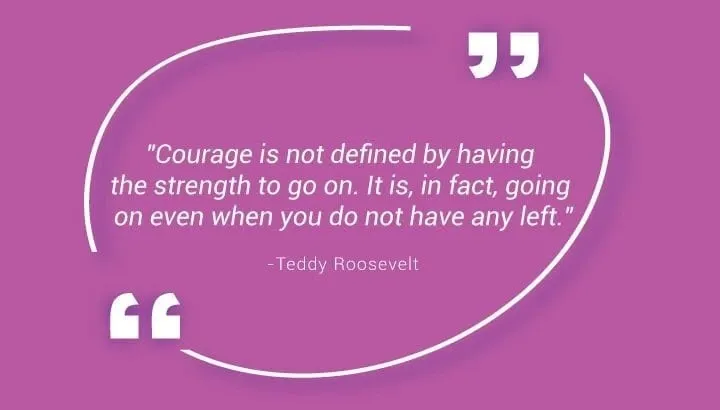100+ Meilleures citations de motivation pour la vente afin d'inspirer votre équipe
Vous avez du mal à motiver vos vendeurs ? Ces 100 citations de motivation commerciale inspireront votre équipe, la motiveront et la pousseront à conclure plus d'affaires en toute confiance. Parfaites pour tous les professionnels de la vente !
Sur cette page
La vente peut être un défi, et il est essentiel de rester motivé pour réussir. Que vous soyez confronté à des obstacles, en quête d'encouragement ou que vous cherchiez à inspirer votre équipe, les mots justes peuvent faire la différence.
C'est pourquoi nous avons compilé plus de 100 citations motivantes de vendeurs influents, de chefs d'entreprise, d'entrepreneurs et de penseurs. Ces citations motivantes pour l'équipe de vente vous aideront à rester concentré, à repousser vos limites et à affiner vos compétences en matière de vente.
Laissez cette collection de citations sur la motivation des vendeurs vous guider vers une plus grande réussite et un état d'esprit plus fort. Mais avant cela, il convient de comprendre ce que représente l'équipe de vente.
Types d'équipes de vente
La motivation devrait être une priorité pour les entreprises qui cherchent à développer une équipe de vente compétente et productive, quelles que soient les crises mondiales. C'est pourquoi, pour trouver les meilleurs moyens demotiver votre équipe de venteil est essentiel de comprendre à quels types d'incitations les vendeurs réagissent le plus. En règle générale, il existe deux types d'équipes de vente : les équipes de vente de produits et les équipes de vente de solutions :
- Les ventes de produitssont généralement des ventes standard et impliquent des vendeurs très motivés et orientés vers un objectif. Ils sont susceptibles de réagir aux récompenses financières et à la reconnaissance de leurs réalisations. Parmi les moyens de les reconnaître, on peut citer les tableaux de bord visuels pour les vendeurs les plus performants,les rémunérer à la commissionpériodiquement, et leur donner le sentiment d'être appréciés.
- Les ventes de solutionsconcernent généralement des produits conçus pour répondre à l'objectif final du client. Les vendeurs de solutions ont tendance à se concentrer sur la satisfaction du client plutôt que sur le chiffre d'affaires. Ils sontmotivés par la reconnaissancepour leur capacité à résoudre les problèmes des clients de manière intelligente et efficace. Les promotions basées sur des enquêtes auprès des clients, par exemple, sont une bonne idée.
Vous avez une carrière dans la vente ou vous débutez. Quel que soit votre rôle dans la vente, le besoin de motivation est toujours présent. Voici une liste de 48 citations motivantes sur la vente pour vous aider à démarrer.
100 + Meilleures citations pour motiver les équipes de vente à atteindre leurs objectifs
Si vous pouvez toujours déployer des systèmes spécifiques (et vous devez le faire) pourmaximiser la productivité de votre équipe de venteet les performances ultérieures de votre équipe de vente, les paroles de sagesse prononcées au bon moment peuvent stimuler votre équipe de vente comme rien d'autre ne peut le faire.
Qu'ils aient du mal à trouver les bons prospects ou qu'ils soient nerveux à l'idée de prendre des risques pendant la pandémie, voici les meilleures citations de motivation pour la réussite de l'équipe de vente à partager avec vos vendeurs et à leur insuffler une énergie renouvelée. Vous nous remercierez plus tard !
Citations motivantes pour les équipes de vente
1. Les gens sont affamés d'esprit de décision. Si vous pouvez le leur donner, vous pouvez dominer le monde.
2. Si vous ne vous occupez pas de vos clients, vos concurrents le feront certainement ! Ce n'est pas ce que vous souhaitez dans le contexte économique actuel. Alors, ressaisissez-vous et mettez-vous au travail.
3. La confiance l'emporte sur les transactions. Ne décevez jamais vos clients. Ils doivent toujours être votre première priorité, quoi qu'en disent les autres.
4. Identifiez ce qui vous relie aux autres êtres humains plutôt que ce qui vous en sépare. La vente consiste à comprendre les défis auxquels un client est confronté, à faire preuve d'empathie à son égard et à établir des liens.
5. Résolvez les problèmes de vos clients et ils vous seront fidèles pour toujours !
Devis de prospection commerciale
6. On ne peut pas vendre aux autres si l'on n'est pas soi-même vendu.
7. Le retour d'information est ce que les champions apprécient le plus. N'ayez pas peur d'obtenir un retour d'information de temps en temps. C'est un outil formidable pour s'améliorer.
8. Attendez le oui et acceptez le non. C'est ainsi que l'on maîtrise la fermeture !
9. La clarté est un pouvoir. Personne ne peut accomplir quoi que ce soit sans clarté.
10. Faites ce que les autres ne font pas, et vous obtiendrez ce que les autres n'obtiendraient pas.
11. Le charisme peut vous ouvrir des portes, mais c'est le caractère qui vous permettra de rester dans le bâtiment. Travaillez continuellement sur vous-même.
12. N'arrêtez jamais, jamais, jamais de faire un suivi. Cela peut être éprouvant pour les nerfs, mais c'est essentiel dans le jeu de la vente !
Citations inspirantes pour l'équipe de vente
13. "Commencez par espérer de grandes choses pour vous-même. Ensuite, allez-y et faites-les. Ne laissez rien ni personne vous empêcher d'atteindre vos objectifs." - Michael Jordan
14. Le secret de la réussite réside dans le fait de commencer. Commencez dès maintenant. Qu'attendez-vous ?
15. "Vous êtes ce que vous faites de manière répétée. Faites de l'excellence une habitude, et non un acte que vous faites une fois de temps en temps." - Aristote
16. 97 % des personnes qui abandonnent trop tôt sont employées par les 3 % qui n'ont jamais abandonné ! N'abandonnez jamais.
17. "Je ne crains pas l'homme qui a pratiqué 10 000 coups de pied une fois, mais je crains l'homme qui a pratiqué un coup de pied 10 000 fois. - Bruce Lee
18. Entraînez-vous comme si vous n'aviez jamais gagné ; jouez comme si vous n'aviez jamais perdu ! C'est ainsi que l'on s'épanouit en tant que vendeur !
19. Les personnes qui se demandent si le verre est à moitié vide ou plein passent à côté de l'essentiel. Le verre est remplissable. Ne cessez pas d'essayer de conclure cette affaire, quel que soit le nombre d'échecs que vous rencontrez.
20. Luttez en silence avec détermination. Laissez votre succès faire du bruit.
21. "Les amateurs s'assoient et attendent d'être inspirés. Les autres se lèvent et se mettent au travail." - Stephen King
22. Se concentrer sur les progrès, pas sur la perfection.
23. La vente ne consiste pas à être parfait, mais à être persévérant.
24. Un vendeur qui réussit se lève chaque matin avec détermination et se couche avec satisfaction. La persévérance sera votre meilleure amie.
25. Si vous êtes la personne la plus intelligente de la pièce, vous n'êtes pas au bon endroit. Changez de pièce, changez de vie !
Les meilleures citations pour motiver les vendeurs et atteindre leurs objectifs
26. "Je n'ai pas de rêves, j'ai des objectifs. - Harvey Specter
27. Le succès n'est jamais possédé, seulement loué - et le loyer est dû tous les jours. Alors, mettez-vous au travail dès aujourd'hui. N'arrêtez jamais de vous démener.
28. Le fait vaut mieux que la perfection.
29. "Gagner n'est pas tout, mais vouloir gagner l'est. C'est l'attitude qui distingue les grands vendeurs des autres." - Vince Lombardi
30. Le rêve est gratuit, mais l'agitation ne l'est pas ! Préparez-vous à passer de longues nuits, à travailler les week-ends et à respecter des délais très serrés. La récompense en vaut la peine.
31. Si vous le voyez dans votre tête, un jour ou l'autre, vous le verrez devant vos yeux.
32. Ne vous contentez pas de travailler DANS votre entreprise, travaillez SUR elle. C'est ainsi qu'il devrait toujours en être ainsi.
Citations courageuses pour la motivation de l'équipe de vente
33. La qualité des questions que vous vous posez détermine la qualité de votre vie. Si vous ne vous remettez pas en question, que faites-vous au juste ?
34. "Soyez malheureux ou motivez-vous. C'est toujours à vous de choisir ce que vous êtes censé faire." - Wayne Dyer
35. "Le courage ne se définit pas par le fait d'avoir la force de continuer. C'est, en fait, continuer même quand il ne vous reste plus rien." - Teddy Roosevelt

36. Votre passé n'est pas synonyme d'avenir.
37. Votre valeur personnelle déterminera votre valeur nette.
38. Le succès arrive au moment précis où l'on n'en a pas envie.
39. Lorsque vous avez envie d'abandonner, pensez à la raison pour laquelle vous avez commencé.
40. Chaque fois que vous avez l'impression d'avoir échoué, rappelez-vous que même Coca Cola n'a vendu que 25 bouteilles au cours de sa première année d'existence. Le succès prend du temps.
Citations de vendeurs motivés pour prendre des risques
41. Vous devez accepter de perdre si vous êtes vraiment déterminé à gagner.
42. Si vous ne pouvez pas le faire, vous devez le faire.
43. La différence entre la peur et l'excitation réside dans la façon dont vous y pensez.
44. "On rate 100 % des coups que l'on ne prend pas. Parfois, tout ce qu'il faut, c'est faire le premier pas pour commencer à se reposer, à suivre." - Wayne Gretzky
45. Parfois, plus tard devient jamais. Ne laissez rien vous empêcher de le faire maintenant.
46. Les grandes choses ne viennent jamais des zones de confort.
47. Les courriels qui ne sont pas envoyés ne permettent pas de conclure des affaires.
48. La peur est le signe de la croissance et du succès.
Citations positives sur les ventes
- Le succès se construit sur de petites victoires. Célébrez chacune d'entre elles et les grandes victoires suivront.
- L'énergie que vous apportez à une conversation est l'énergie que vous recevrez en retour. Restez positif, restez confiant !
- Un refus aujourd'hui n'est qu'un tremplin pour une vente demain. Ne lâchez rien !
- Les meilleurs vendeurs ne recherchent pas les commissions, ils recherchent l'impact. L'argent suit.
- Vous n'êtes qu'à une conversation de votre plus grande percée. Continuez à composer, continuez à sourire !
- La vente ne consiste pas à vendre un produit, mais à résoudre un problème. C'est ce qu'il faut faire et les ventes viendront.
- La meilleure façon de prédire le succès est de le créer, une vente à la fois.
- Il n'est pas nécessaire d'être le meilleur pour commencer ; il suffit de commencer à être le meilleur.
- Une bonne attitude donne de bons résultats. Restez enthousiaste et le succès suivra.
- Chaque "non" que vous entendez vous rapproche du "oui" que vous attendez !
Citations drôles sur les ventes
- La vente est le seul métier où l'on est rejeté 95 % du temps et où l'on se sent toujours gagnant !
- Si vendre était facile, tout le monde le ferait. Heureusement pour nous, ce n'est pas le cas !
- La seule chose plus froide qu'un appel froid est un café froid - alors buvez et continuez à composer !
- La berceuse préférée des vendeurs : "Je vais y réfléchir..."
- Vendre, c'est comme draguer. S'ils disent "Je dois y réfléchir", c'est qu'ils ne sont probablement pas intéressés par vous.
- "J'adore les objections", n'a jamais dit aucun vendeur, mais elles signifient que vous êtes dans le jeu !
- Suivi : parce que le "ghosting" n'est plus réservé aux applications de rencontres.
- Le secret de la réussite ? Porter des chaussures confortables. Vous resterez debout jusqu'à ce que vous le fassiez !
- La vente est la seule carrière où le rejet forge le caractère et les commissions la motivation.
- Si l'enthousiasme était une monnaie, les vendeurs seraient tous milliardaires.
Citations sur le leadership en matière de vente
- Un leader ne crée pas de suiveurs, il crée d'autres leaders. Inspirez votre équipe à s'élever.
- Les meilleurs directeurs commerciaux ne se contentent pas de fixer des objectifs ; ils créent des mentalités gagnantes.
- Le leadership commercial ne consiste pas à être le meilleur vendeur, mais à aider les autres à donner le meilleur d'eux-mêmes.
- Une bonne équipe de vente repose sur la confiance, la motivation et une réserve inépuisable de café !
- Les chiffres sont importants, mais les personnes le sont encore plus. Établissez des relations solides et les ventes suivront.
- Les meilleurs leaders commerciaux accompagnent et ne commandent pas. Élevez votre équipe vers l'excellence.
- Un bon dirigeant écoute. Un grand leader agit en fonction de ce qu'il entend.
- Votre équipe vendra votre façon de diriger. Montrez-leur de la confiance, de la persistance et de la résilience.
- Le travail d'un dirigeant n'est pas de conclure des affaires, mais de mettre en place une équipe qui y parviendra.
- Le leadership, c'est plus que des quotas ; c'est une question de culture, de cohérence et d'engagement.
Clôture des devis de vente
- La proximité commence par le bonjour. Donnez le ton dès la première interaction.
- Les gens n'achètent pas par logique, ils achètent par confiance. Montrez-leur pourquoi ils ont besoin de vous.
- Ne demandez jamais la vente, assumez-la. La confiance en soi permet de conclure des affaires.
- La chance est dans le suivi. Demandez toujours, rappelez toujours, fermez toujours.
- Un bon agent de liaison ne vend pas, il guide le client vers la décision qu'il souhaite déjà prendre.
- "Je vais y réfléchir" n'est qu'une autre façon de dire "Convainquez-moi encore une fois".
- La confiance permet de conclure plus d'affaires que les remises ne le feront jamais.
- Vendez le résultat, pas le produit. La bonne conclusion parle de l'avenir du client.
- Votre meilleure technique de conclusion ? Croire en ce que vous vendez.
- Si vous avez peur de demander la conclusion, vous avez déjà perdu la vente.
Citations sur la réussite des ventes
- Les meilleurs vendeurs n'attendent pas les opportunités, ils les créent.
- Le succès dans la vente est comme un marathon : il faut suivre son rythme, rester constant et ne jamais abandonner.
- Les 1 % de vendeurs les plus performants font ce que les 99 % restants ne font pas.
- Maîtrisez votre discours, maîtrisez votre état d'esprit, maîtrisez la vente.
- Un vendeur qui réussit est toujours en train d'apprendre, de se perfectionner et de conclure.
- La vente est une affaire de chiffres, mais la réussite est une affaire d'état d'esprit. Gagnez sur les deux tableaux.
- Chaque appel, chaque présentation, chaque suivi est une opportunité. Prenez-le au sérieux.
- Le succès ne consiste pas à conclure toutes les affaires, mais à ne jamais renoncer à la suivante.
- Les meilleurs vendeurs ne se contentent pas d'atteindre leurs objectifs, ils en fixent de nouveaux.
- Le succès dans la vente repose sur une seule chose : se présenter chaque jour.
L'expérience des clients en matière de devis de vente
- Les clients n'achètent pas seulement des produits, ils achètent des expériences. Rendez la vôtre inoubliable.
- Le moyen le plus simple de vendre ? Faire en sorte que vos clients se sentent écoutés, appréciés et compris.
- Un client satisfait est le meilleur marketing que vous puissiez avoir.
- Si vous traitez vos clients comme des transactions, ils vous traiteront comme des reçus, facilement oubliés.
- Votre produit est important, mais votre relation avec le client est primordiale.
- Vendez avec intégrité, servez avec excellence, et le succès suivra.
- Les meilleurs vendeurs ne sont pas seulement des vendeurs, ce sont des conseillers de confiance.
- Une expérience client exceptionnelle transforme un acheteur ponctuel en un partisan de longue date.
- Les gens se souviennent davantage de ce qu'ils ressentent que de ce que vous leur vendez.
- La meilleure technique de fermeture ? Laisser les clients si heureux qu'ils reviennent d'eux-mêmes.
Conseils pour motiver votre équipe de vente
Tout en aidant vos vendeurs à améliorer leurscompétencesgrâce à lagestion des performances, il est facile de les aider à rester motivés. Chaque personne a tendance à réagir différemment aux différents types de motivation, et il y a toujours des facteurs externes à prendre en compte.
1. Demandez à vos subordonnés directs quel type de management ils préfèreraient.
Les managers efficaces sont prêts à s'adapter à ce que leurs vendeurs préfèrent en termes de nombre d'appels ou d'interactions par semaine, de type de retour d'information, de nature des récompenses et de la reconnaissance, et de degré de franchise.
En demandant aux vendeurs comment ils aimeraient être gérés, la confiance peut être renforcée et chacun peut être plus productif et motivé au travail.
2. Leur permettre de choisir leurs récompenses
Les cadeaux génériques ne font pas toujours l'unanimité auprès des employés. Donnez-leur la possibilité de choisir leurs récompenses dans le cadre d'un budget précis. En outre, les récompenses ne doivent pas nécessairement être monétaires.
Automatiser les primes et les commissions versées aux équipes de vente à l'aide de Compass, unlogiciel de gamification des incentives.
3. Comprendre leurs objectifs personnels et professionnels
Pour motiver les employés, il faut comprendre ce qui les motive. Demandez-leur ce qui compte pour eux dans leur vie personnelle et professionnelle, dans quelle mesure ils sont motivés pour atteindre ces objectifs et quel rôle vous jouez pour les aider à atteindre ces objectifs.
Demandez-leur de réfléchir à la question pendant un jour ou deux et de vous recontacter ensuite - cela les incitera à donner des réponses plus réfléchies qui vous aideront mieux à long terme.
4. Incorporer la gamification
Les citations motivantes peuvent susciter l'inspiration, mais soyons honnêtes, la vente est un jeu à haute pression. Lorsque le rejet frappe durement et que la motivation faiblit, la fonction de gamification deCompass de Compass intervient pour transformer les difficultés en un défi qui vaut la peine d'être relevé.

Voici comment Compass peut aider votre équipe de vente à rester motivée, productive et engagée :
Rendre les ventes amusantes et gratifiantes
Le rejet et la répétition font partie de la vente, mais avec le logiciel de gamification de Compass, vous pouvez transformer le travail quotidien en une compétition passionnante. Les représentants restent motivés lorsqu'ils apprécient le processus, et c'est exactement ce que Compass leur offre.
Organiser des concours sur les indicateurs de performance clés qui comptent
Vous voulez augmenter le nombre de contrats conclus ? Augmenter le nombre d'appels ? Augmenter les commissions ? Liez les concours de vente aux indicateurs clés de performance qui ont un impact sur les revenus des représentants, car lorsque leur succès se traduit par des récompenses réelles, la motivation monte en flèche.
Accroître la responsabilisation grâce à la visibilité sur l'atteinte des quotas
Lorsque les représentants savent exactement où ils se situent, ils poussent plus fort. Des tableaux de bord personnalisés, des classements en temps réel et des tableaux de bord d'équipe garantissent une visibilité totale sur l'atteinte des quotas, ce qui favorise une concurrence saine et des performances accrues.
Suivre les performances et repérer les tendances
Le coaching basé sur les données devient facile à mettre en œuvre grâce aux informations en temps réel. Les responsables des ventes peuvent analyser les tendances, suivre les performances et affiner les stratégies, aidant ainsi les représentants à se développer tout en rendant les concours plus efficaces.
Reconnaître et récompenser les réalisations
Qu'il s'agisse de points, de badges, de nudges alimentés par l'IA ou de suivi des paiements, Compass rend le succès visible et gratifiant. Et lorsque les commerciaux voient que leur travail acharné est reconnu, ils restent dans le jeu.
Une belle citation peut inspirer, mais un concours bien conçu incite à l'action. Avec Compass, la motivation n'est pas un moment fugace - elle est intégrée dans le flux de travail quotidien de votre équipe.
Pour conclure
Quel que soit le secteur d'activité ou la taille de l'entreprise, les vendeurs doivent être constamment sur la brèche pour atteindre leurs objectifs, attirer de nouveaux clients et contribuer à la croissance de l'entreprise.
Ils sont un atout pour l'organisation qui a besoin d'être nourri et motivé en permanence. Nous espérons que ces 100+ meilleures citations de motivation pour l'équipe de vente vous aideront à donner un ton positif à vos équipes de vente pour la nouvelle année.
Vous voulez savoir comment motiver votre équipe de vente ? Comment appliquer les bonnes stratégies de motivation ? Tout ce dont vous avez besoin, c'est de Compass, le logiciel de gamification des ventes par excellence pour motiver votre équipe de vente. Prêt à alimenter la motivation de votre équipe de vente au-delà des mots ?
Essayez Compass et transformez la vente en un jeu passionnant et axé sur les résultats !
FAQs
1. Quelle est la citation la plus inspirante pour la vente ?
"Le succès n'est jamais possédé, seulement loué - et le loyer est dû tous les jours. Cette citation rappelle aux vendeurs que la constance et l'effort sont la clé du succès à long terme.
2. Que dire pour encourager une équipe de vente ?
Chaque "non" vous rapproche d'un "oui". Restez persévérant, faites confiance au processus et continuez à aller de l'avant !
3. Quelle est une bonne citation sur la vente ?
"La vente ne consiste pas à être parfait, mais à être persévérant.
4. Quelle est la plus grande motivation dans la vente ?
La plus grande motivation dans la vente est la capacité à contrôler son propre succès, qu'il s'agisse de commissions, d'évolution de carrière ou du plaisir de conclure une grosse affaire.-qu'il s'agisse de commissions, d'évolution de carrière ou de l'excitation de conclure une grosse affaire.
5. Qu'est-ce qu'un devis de vendeur ?
"Vous ratez 100 % des tirs que vous ne prenez pas. - Wayne Gretzky. Un rappel classique que l'action est la clé du succès dans la vente.













